The Gas Jet Compressor Market is estimated to be valued at USD 3.2 billion in 2025 and is projected to reach USD 4.9 billion by 2035, registering a compound annual growth rate (CAGR) of 4.5% over the forecast period.
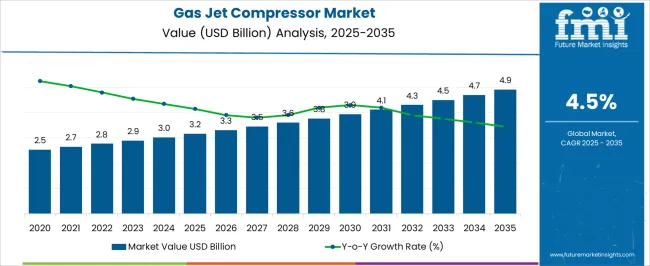
| Metric | Value |
|---|---|
| Gas Jet Compressor Market Estimated Value in (2025 E) | USD 3.2 billion |
| Gas Jet Compressor Market Forecast Value in (2035 F) | USD 4.9 billion |
| Forecast CAGR (2025 to 2035) | 4.5% |
The gas jet compressor market is showing steady expansion, supported by its critical role in handling gases across industries such as oil and gas, chemical processing, and power generation. Jet compressors offer operational advantages such as simple design, minimal maintenance, and high reliability under varying pressure conditions.
The current market scenario reflects rising energy demand and the need for efficient gas compression systems in upstream and midstream oil and gas activities. Technological innovations aimed at improving performance and reducing operational costs have further strengthened adoption.
Future growth is expected to be driven by investments in oil exploration, natural gas infrastructure, and process industries that require stable gas handling solutions. With emphasis on energy efficiency and system reliability, the market is positioned for sustained development.
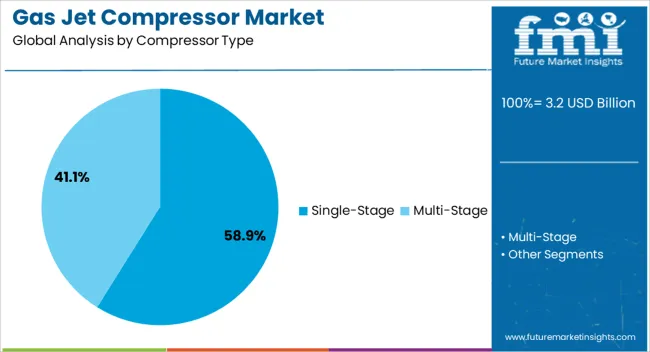
The single-stage segment dominates the compressor type category with approximately 58.9% share, supported by its cost-effectiveness and suitability for medium-duty applications. Its simple design, lower capital investment, and ease of maintenance have reinforced its preference across industries.
Single-stage compressors are widely used in applications where moderate compression ratios are sufficient, making them suitable for oil exploration, chemical processing, and power plant operations. The segment benefits from high reliability and robust performance in continuous operations.
With increasing demand for streamlined, energy-efficient systems, the single-stage segment is projected to maintain its significant market share.
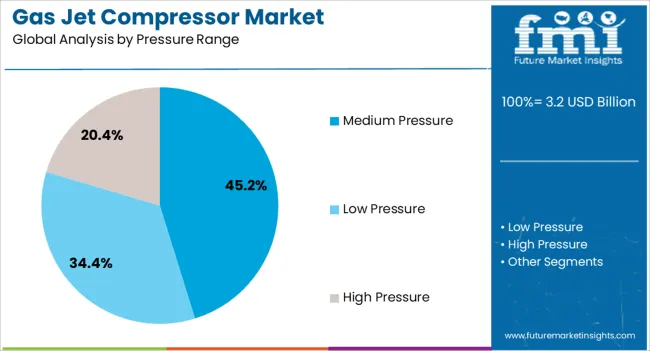
The medium pressure segment leads the pressure range category, holding approximately 45.2% share. This dominance is attributed to its versatility in industrial operations requiring balanced performance between low and high pressure ranges.
Medium pressure compressors are widely utilized in process industries and oil exploration, where stable and efficient gas handling is essential. The segment benefits from its adaptability to diverse operational environments and lower energy consumption compared to high-pressure systems.
Demand is reinforced by ongoing infrastructure projects and oilfield developments that require reliable medium pressure operations. With continuous expansion of energy and industrial sectors, the medium pressure segment is expected to retain its leading position.
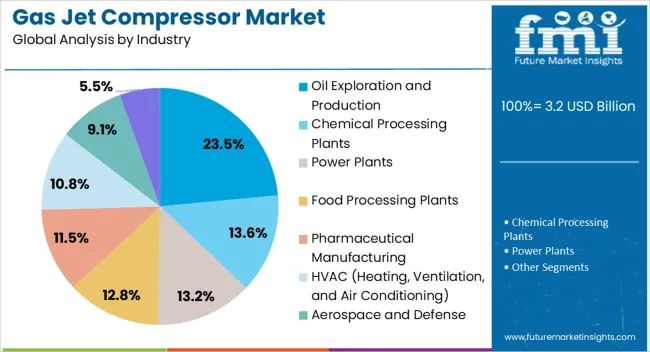
The oil exploration and production segment accounts for approximately 23.5% share in the industry category, reflecting its reliance on gas jet compressors for various upstream applications. Compressors are utilized in gas injection, vapor recovery, and pressure maintenance, ensuring efficient reservoir performance and operational stability.
The segment benefits from global investments in new exploration projects and enhanced recovery techniques, particularly in offshore fields. With increasing focus on maximizing output from mature reservoirs, demand for efficient compression systems has grown.
The segment’s outlook remains positive as oil producers continue to prioritize operational efficiency and cost control, ensuring gas jet compressors retain their relevance in the sector.
Offering Customizations in the Compressors to the End Users
Gas jet compressor manufacturers are progressively offering modular and customizable solutions to meet the diverse needs of different industries. Modular designs facilitate system installation, maintenance, and scalability, while customization of compressors allows them to be tailored to specific operating conditions and needs.
Customization entails working closely with consumers to determine important parameters like operating conditions, pressure levels, and capacity before developing and producing unique solutions in accordance with those standards.
Manufacturers may guarantee that their compressor systems completely match the applications of end users by providing customized configurations, features, and functions. This leads to improved performance, efficiency, and user satisfaction.
Oil-free Compressors to Penetrate the Market, enhancing Investment Prospects
There is a notable increase in the gas jet compressor market growth rate owing to the demand for oil-free compressors. Oil-free compressors are being used by industries, especially those in delicate applications like food processing and pharmaceuticals, to guarantee the purity of the gas being compressed.
The 'Aerzen Turbo G5plus' series gas jet compressors are one type of oil-free compressor. These compressors are appropriate for situations where oil contamination is a problem. This includes the food and beverage sector or pharmaceutical manufacturing since they use innovative turbo technology to produce oil-free compression.
Upgradation Woes, Gas Jet Compressor Demand May experience a Blip given elevated Investment Expenditure
Adopting and upgrading the gas jet compressors is a major roadblock to the key players. This is taking place due to various reasons. Investing in new equipment requires higher initial costs and huge investments, becoming a significant challenge. Upgraded versions may include disruptions in operations and impede entry of the players to the global gas jet compressor market.
Another factor restraining the upgradation is unpredictability about the return on investment in terms of increased productivity or efficiency. Players, at times, face compatibility issues with the existing infrastructure due to a lack of expertise and trained personnel.
The gas jet compressor market size and growth potential historically reached a 4.2% CAGR. In 2025, the industry acquired a valuation of USD 2,894.6 million. With each passing day, use of gas jet compressors has extended to a wide range of sectors.
Key application areas include oil exploration and production, chemical processing plants, power plants, food processing plants, pharmaceutical manufacturing, HVAC (heating, ventilation, and air conditioning), and aerospace and defence.
| Attributes | Historical Data |
|---|---|
| CAGR from 2020 to 2025 | 4.2% |
| Valuation in 2020 | USD 2,464.8 million |
| Valuation in 2025 | USD 2,894.6 million |
Gas jet compressor manufacturers have historically concentrated on providing basic, off-the-shelf compressor products with minimal customization. These compressors lacked advanced functions or customized setups since they were intended for general-purpose uses.
Manufacturers prioritized cost-effectiveness and mass manufacturing above customization, which could fulfill end-user needs and enhance compressor performance for a range of industrial applications.
The use of artificial intelligence and machine learning have been gaining significance in the gas jet compressor market eventually. Players are developing advanced control systems with AI and ML in this industry.
This is aiding the players in optimizing compressor performance, predicting maintenance needs, and enhancing the system efficiency. Manufacturers are thus able to offer their consumers more energy-efficient and reliable solutions while reducing costs and operational downtime.
In this section, a comparative analysis will be drawn among two similar industries. The industries to be compared and analyzed are the industrial air compressor industry and refrigeration compressor industry.
The industrial air compressors industry, and refrigeration compressors industry are linked by common production techniques and technical developments. All industries gain from advances in compressor design, materials, and efficiency, which encourage industry cooperation as well as knowledge sharing.
Innovations in one field frequently spur innovations in another, which advances compression technology generally across a range of industries and applications.
Industrial Air Compressor Industry Assessment:
Increase in different kinds of industrial activities to spur the sales of industrial air compressors globally. In developing countries, such as Russia, India, and China, industrialization is gaining traction, and hence, the demand for these compressors is increasing.
The oil and gas sector is an important end-use area for industrial air compressors. This can be attributed to the need to support the transportation pipeline. Factors such as these are going to open up new opportunities for the market in the future.
| Attributes | Industrial Air Compressor Market |
|---|---|
| CAGR from 2025 to 2035 | 8.2% |
| Growth Factor | Adoption of advanced technologies to enhance the efficacy of the compressors. |
| Opportunity | The market for industrial air compressors is anticipated to rise steadily due to fast industrialization and increasing investment in mechanical equipment. |
| Trend | Since air compressors are widely used in pipelines for the transportation of gas and oil, demand for them in the oil and gas industry is significantly increasing. |
Refrigeration Compressor Industry Assessment:
The increasing number of retail outlets, expanding FMCG sector, and strengthening capabilities of cold chain facilities boost the demand for these compressors. These compressors are extensively used across retail food outlets, chemical, food and beverage, healthcare, transportation, and residential sectors. The global food insecurity along with food product exports are also supporting the sales of refrigeration compressors.
| Attributes | Refrigeration Compressor Market |
|---|---|
| CAGR from 2025 to 2035 | 3.6% |
| Growth Factor | Transportation of perishable products requires these compressors. |
| Opportunity | Over the projection period, it is expected that the FMCG industry's growth, the expansion of retail locations, and the development of cold chain capabilities will increase demand for refrigeration compressors and refrigerators. |
| Trend | The global refrigeration compressor market has significant development potential due to increased food insecurity and expanding food exports. |
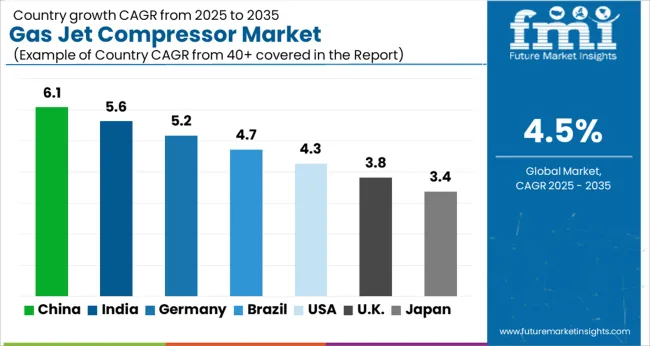
In this section, an analysis will be drawn on the demand for gas jet compressors in a few of the key countries. This includes the United States, Canada, Germany, the United States and South Korea.
Out of these countries, the demand will be majorly from Canada, garnering a 4% CAGR during the forecast period. This is owing to the increasing sustainability standards and regulations in the country. The use of these compressors in the United Kingdom and South Korea has been almost the same, and the same growth rate is expected from these two countries during the forecast period.
Players in all of these countries are looking forward to developing more efficient compression technologies. This would support the various global transportation infrastructure projects and energy production initiatives.
The gas jet compressor ecosystem in the United States is set to gain a 3.4% CAGR through 2035. In the United States, a technology that is dominantly being used is computational fluid dynamics (CFD). This technology helps in the precise simulation and modeling of fluid flow within the gas jet compressors.
Players are utilizing computational fluid dynamics on a wide scale to improve the design and optimize effective compression systems. This helps the manufacturers as well as the end use industries in reducing their costs and improving efficiency.
Ariel Corporation, for example, has been using this technology for a long time to enhance its overall productivity. The cost-effectiveness of gas jet compressors compared to other compression technologies is gaining the attention of other key players.
The United Kingdom ecosystem is set to gain a 3.8% CAGR from 2025 to 2035. One of the main reasons gas jet compressors are used in the United Kingdom is that the natural gas transportation industry has to cut emissions and improve efficiency.
Innovative compressor solutions are offered by companies like as Dresser-Rand, a Siemens company, to serve the gas infrastructure in the United Kingdom. Effective compression technology is crucial for preserving the sustainability and dependability of the natural gas supply chain.
The role of gas jet compressors in a sustainable energy future enables a range of industrial and residential uses, given its dedication to lowering greenhouse gas emissions.
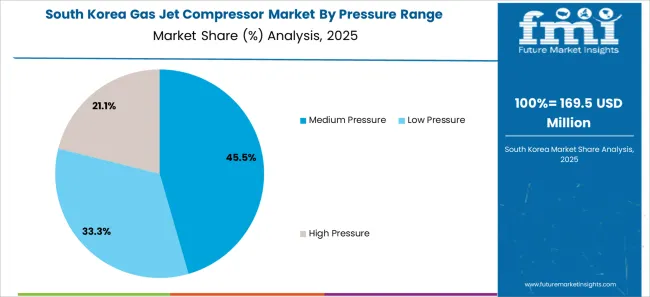
The demand for these compressors in South is going to achieve a 3.8% CAGR from 2025 to 2035. The role of gas jet compressors in hydrogen production and storage for clean energy applications is aiding growth in South Korea.
The country is making investments in hydrogen production, storage, and transportation as part of its strong commitment to renewable energy and hydrogen economy efforts. As the nation strives to become an international player in the hydrogen economy, gas jet compressors are essential for compressing hydrogen for a variety of uses, including fuel cell automobiles and industrial activities.
This section analyzes two particular segments for the gas jet compressor market: the dominant compressor type and the significant industry. The two main segments discussed below are single-stage compressors and the oil and gas industry.
| Compressor Type | Single Stage Compressor |
|---|---|
| Market Share in 2025 | 58.9% |
Single stage compressor is going to acquire a 58.9% gas jet compressor market share in 2025. These compressors are going to be highly preferred by manufacturers due to their simplicity, low cost, and applicability to certain applications.
Compared to multi-stage compressors, single-stage compressors are simpler to set up, run, and maintain as they contain fewer moving parts. They are also ideal for applications with relatively moderate pressure needs when the advantages of multi-stage compression are outweighed by the ease of use and lower starting costs of single stage compressors.
| Industry Type | Oil and Gas Industry |
|---|---|
| Market Share in 2025 | 23.5% |
The use of these compressors to find a wide range of applications in the oil and gas sector, along with a 23.5% market share in 2025. The oil and gas industry is expected to utilize gas jet compressors extensively owing to their effectiveness in processing gas, moving it via pipelines, and storing it.
Gas jet compressors are essential for streamlining production procedures and guaranteeing the uninterrupted flow of gas throughout the industry's infrastructure due to their dependability and small size. They are progressively emerging as a favored option for augmenting operational effectiveness within the oil and gas sector.
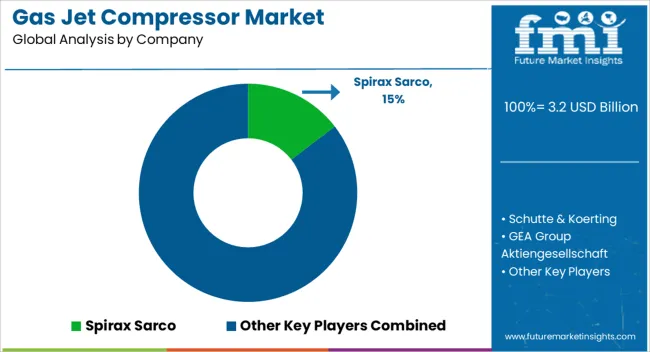
Maximizing operational efficiency and meeting the ever increasing industrial demand across various sectors are the two factors that the players are focusing on. Manufacturers are developing these compressors for purposes including distributing, storing, transporting, processing, and extracting natural gas directly from the wellhead to the end user.
Players are trying to stand out in the global gas jet compressor market by utilizing expert manufacturing and design, unmatched and continuous customer support, and quality research and development initiatives. The growth of the oil & gas, chemical, and power generation industries driving demand for gas jet compressors and becoming a benefit for the players.
Manufacturers are vying for maximizing operational longevity, which in turn minimizes the compressor’s lifetime ownership costs. Startups, too are trying hard to enter the global gas jet compressor market via various strategies. Their focus is on cost-effective, compact, and efficient technologies and solutions.
Addressing the multiple drawbacks of traditional jet compressors, like environmental impact, maintenance requirements, and high energy consumption, is what the startups are doing at present.
With the aid of innovation, they are reducing operational costs, enhancing compression efficacy, and promoting various sustainable industrial practices. The rising cost of traditional compression technologies and the potential cost benefits of gas jet compressors is another factor startups are focusing on.
For example, Croll Reynolds established a pilot unit in 2025 to determine the optimal operating parameters for a plant production scale, including temperature, load, pressure, vacuum, flow rates, and kind of mist eliminator. The purpose of this was to establish the operational and design criteria for a large-scale production facility.
A 24-inch diameter Scrub-Vactor, a 12 square foot, type 22-A ARM plate type heat exchanger, a 112 square foot vapor-in-tube surface condenser with a condensate tank, an 11.4-inch gear pump with a steam turbine drive, a two-stage, noncondensing evactor are among the apparatus in the pilot plant.
Transvac Systems Limited has been establishing strong partnerships with a number of academic institutions and universities in the United Kingdom. This includes the University of Nottingham and the University of Southampton. The company tends to benefit from its research and development initiatives and provides industrial expertise to aspiring engineers.
| Report Attribute | Details |
|---|---|
| Growth Rate | CAGR of 4.5% from 2025 to 2035 |
| Value in 2025 | USD 3,024.9 million |
| Value in 2035 | USD 4,697.5 million |
| Base Year for Estimation | 2025 |
| Historical Data | 2020 to 2025 |
| Forecast Period | 2025 to 2035 |
| Quantitative Units | USD million for value |
| Report Coverage | Revenue Forecast, Company Ranking, Competitive Landscape, Growth Factors, Trends and Pricing Analysis |
| Segments Covered |
Compressor Type, Pressure Range, Industry, Region |
| Region Covered | North America; Latin America; Western Europe; Eastern Europe; South Asia and Pacific; East Asia; Middle East & Africa |
| Countries Profiled | The United States, Canada, Brazil, Mexico, Germany, United Kingdom, France, Spain, Italy, Poland, Russia, Czech Republic, Romania, India, Bangladesh, Australia, New Zealand, China, Japan, South Korea, GCC Countries, South Africa, Israel |
| Leading Gas Jet Compressor Manufacturers | Spirax Sarco; Schutte & Koerting; GEA Group Aktiengesellschaft; Transvac Systems Limited; Körting Hannover GmbH; EST Venturi Systems; Forbes Marshall; Kadant Inc; Croll Reynolds |
| Customisation Scope | Available on Request |
The industry is classified into single-stage and multi-stage.
The report consists of pressure range like low pressure, medium pressure and high pressure.
The analysis is based on the industrial insights of oil exploration and production, chemical processing plants, power plants, food processing plants, pharmaceutical manufacturing, HVAC (heating, ventilation, and air conditioning), aerospace and defenseand others.
Analysis of the industry has been carried out in key countries of North America, Latin America, Western Europe, South Asia, East Asia, Eastern Europe, and the Middle East and Africa.
The global gas jet compressor market is estimated to be valued at USD 3.2 billion in 2025.
The market size for the gas jet compressor market is projected to reach USD 4.9 billion by 2035.
The gas jet compressor market is expected to grow at a 4.5% CAGR between 2025 and 2035.
The key product types in gas jet compressor market are single-stage and multi-stage.
In terms of pressure range, medium pressure segment to command 45.2% share in the gas jet compressor market in 2025.






Full Research Suite comprises of:
Market outlook & trends analysis
Interviews & case studies
Strategic recommendations
Vendor profiles & capabilities analysis
5-year forecasts
8 regions and 60+ country-level data splits
Market segment data splits
12 months of continuous data updates
DELIVERED AS:
PDF EXCEL ONLINE
Gas Cylinder Market Size and Share Forecast Outlook 2025 to 2035
Gasket and Seal Market Size and Share Forecast Outlook 2025 to 2035
Gas Separation Membrane Market Size and Share Forecast Outlook 2025 to 2035
Gas Fired Water-Tube Food Processing Boiler Market Size and Share Forecast Outlook 2025 to 2035
Gas Fired Real Estate Generator Market Size and Share Forecast Outlook 2025 to 2035
Gastric-soluble Hollow Capsules Market Size and Share Forecast Outlook 2025 to 2035
Gas Cooling System Market Analysis - Size, Share, and Forecast Outlook 2025 to 2035
Gasoline Gensets Market Size and Share Forecast Outlook 2025 to 2035
Gas Insulated Smart Ring Main Unit Market Size and Share Forecast Outlook 2025 to 2035
Gas Turbine Oil Market Size and Share Forecast Outlook 2025 to 2035
Gas Telecom Generator Market Size and Share Forecast Outlook 2025 to 2035
Gas Insulated Ring Main Unit Market Size and Share Forecast Outlook 2025 to 2035
Gas Fired Condensing Low Temperature Commercial Boiler Market Size and Share Forecast Outlook 2025 to 2035
Gas Insulated Medium Voltage Switchgear Market Size and Share Forecast Outlook 2025 to 2035
Gas Commercial Deep Fryers Market Size and Share Forecast Outlook 2025 to 2035
Gastroesophageal Reflux Disease (GERD) Device Market Analysis - Size, Share, and Forecast Outlook 2025 to 2035
Gas Station Equipment Market Size and Share Forecast Outlook 2025 to 2035
Gaskets Market Size and Share Forecast Outlook 2025 to 2035
Gas Chromatography Systems Market Size and Share Forecast Outlook 2025 to 2035
Gas Fueled Power Rental Market Size and Share Forecast Outlook 2025 to 2035

Thank you!
You will receive an email from our Business Development Manager. Please be sure to check your SPAM/JUNK folder too.
Chat With
MaRIA